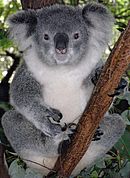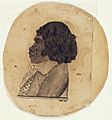Dharug language facts for kids
Quick facts for kids Dharug |
||||
|---|---|---|---|---|
| Sydney lyora |
||||
| Region | New South Wales | |||
| Ethnicity | Dharug, Eora (Yura) (Gadigal, Wangal, Cammeraygal, Wallumettagal, Bidjigal) | |||
| Extinct | Late 19th / early 20th century | |||
| Language family |
Pama–Nyungan
|
|||
| Dialects |
Dharuk
Gamaraygal
Iora
|
|||
| AIATSIS | S64 | |||

|
||||
|
||||

The Dharug language is an Aboriginal language from the Yuin–Kuric group. It was traditionally spoken by the Dharug people in the Sydney, New South Wales area of Australia. You might also see it spelled Darug or Dharuk, or called the Sydney language.
Sadly, the number of Dharug speakers became very small after European settlement. For a long time, people thought the language was extinct. But now, it is being brought back to life as a spoken language by the Dharug community.
Contents
What is the Dharug Language?
Before European settlers arrived, the Dharug people didn't have a specific name for their language. The dialect spoken near the coast was sometimes called Iyora or Eora. This word simply means "people." The dialect spoken further inland was called Dharug.
Some experts believe that the word "Darug" might be linked to "Midyini," which means "yam." Yams were an important food source for the people.
Where Was Dharug Spoken?
Traditional Lands of the Dharug People
The coastal version of the Dharug language was spoken around the Sydney area. This included places like the Sydney Peninsula, north of Botany Bay, and as far north as Broken Bay.
The inland dialect of Dharug was spoken on the Cumberland Plain. This area stretched from Appin in the south to the Hawkesbury River in the north. It also went west of the Georges River and Parramatta.
Who are the Eora People?
The word "Eora" is often used to describe the Aboriginal people of the Sydney region. However, there's no proof that Aboriginal people used this term in 1788 to name their language or group. The word "Eora" means "people" and "from here" or "this place." It refers to the people of the Sydney region and the area they lived in.
Sadly, many Eora people died during the 1800s. This was due to diseases like smallpox and the loss of their traditional food sources.
Early History of the Sydney Region
People have lived in the Sydney area for a very long time. Scientists have found tools that show human activity there at least 30,000 years ago. Some findings even suggest people were there 45,000 to 50,000 years ago!
First European Records of Dharug
William Dawes, a British officer, was one of the first Europeans to write down words from the Dharug language. He arrived with the First Fleet in 1788. He learned from the elder people of Sydney.
Why Did the Language Almost Disappear?
Over time, the Aboriginal people in Sydney started using English more and more. They also used a mix of English and Aboriginal languages called New South Wales Pidgin. This, along with big changes in their way of life, caused the Dharug language to slowly fade away by the late 1800s and early 1900s. By 1875, very few people could speak it fluently.
How is Dharug Being Revived?
The Dharug language was mostly lost because of the impact of European settlement. While some Dharug people remembered words, much of the grammar and sounds were forgotten.
For many years, non-Aboriginal experts collected information about Aboriginal languages to save them. More recently, Aboriginal people themselves are leading the effort to bring their languages back.
Bringing Dharug Back to Life
Since the 1990s, descendants of the Dharug clans in Western Sydney have worked hard to revive Dharug as a spoken language. Today, some modern Dharug speakers give talks in a reconstructed form of the language. Younger community members visit schools to show how Dharug is spoken.
- A recreated version of Dharug is used in welcome ceremonies by the Dharug people.
- In 2005, some students at Chifley College in Sydney started learning the reconstructed Dharug language.
- Parts of the language have also been taught at the Sydney Festival.
- In December 2020, Olivia Fox sang a version of Australia's national anthem, Advance Australia Fair, in Dharug at a rugby match.
How Does Dharug Connect People and Place?
The Dharug language shows a strong connection between people and their land. This is seen in how clan names are formed.
- The ending -gal means "man of."
- The ending -galyan means "woman of."
For example:
- Burramuttagal means "man of Burramutta" (now known as Parramatta). This shows where those specific people are from.
- Gadigal means "man of Gadi" (Sydney).
- Kamaygalyan means "woman of Kamay" (Botany Bay).
This way of naming shows how the Dharug language links people directly to their traditional lands.
English Words from Dharug
Many English words used in Australia actually come from the Dharug language!
Here are some examples:
- Names of animals: dingo, koala, wallaby, wobbegong, wombat
- Trees and plants: burrawang, kurrajong, geebung, myall, waratah
- Tools: boomerang (from the Turuwal sub-group), woomera (a spear-thrower)
- The word gin, which is now considered a very offensive term for an Indigenous woman, is thought to come from the Dharug word diyin, meaning "woman."
- The word koradji, meaning an Aboriginal person with traditional healing skills, also comes from Dharug.
Images for kids
-
A Yuin man, c.1904.
See also
 In Spanish: Idioma dharug para niños
In Spanish: Idioma dharug para niños




